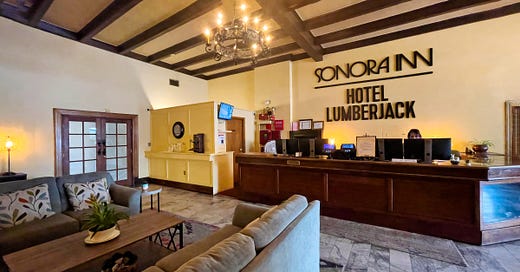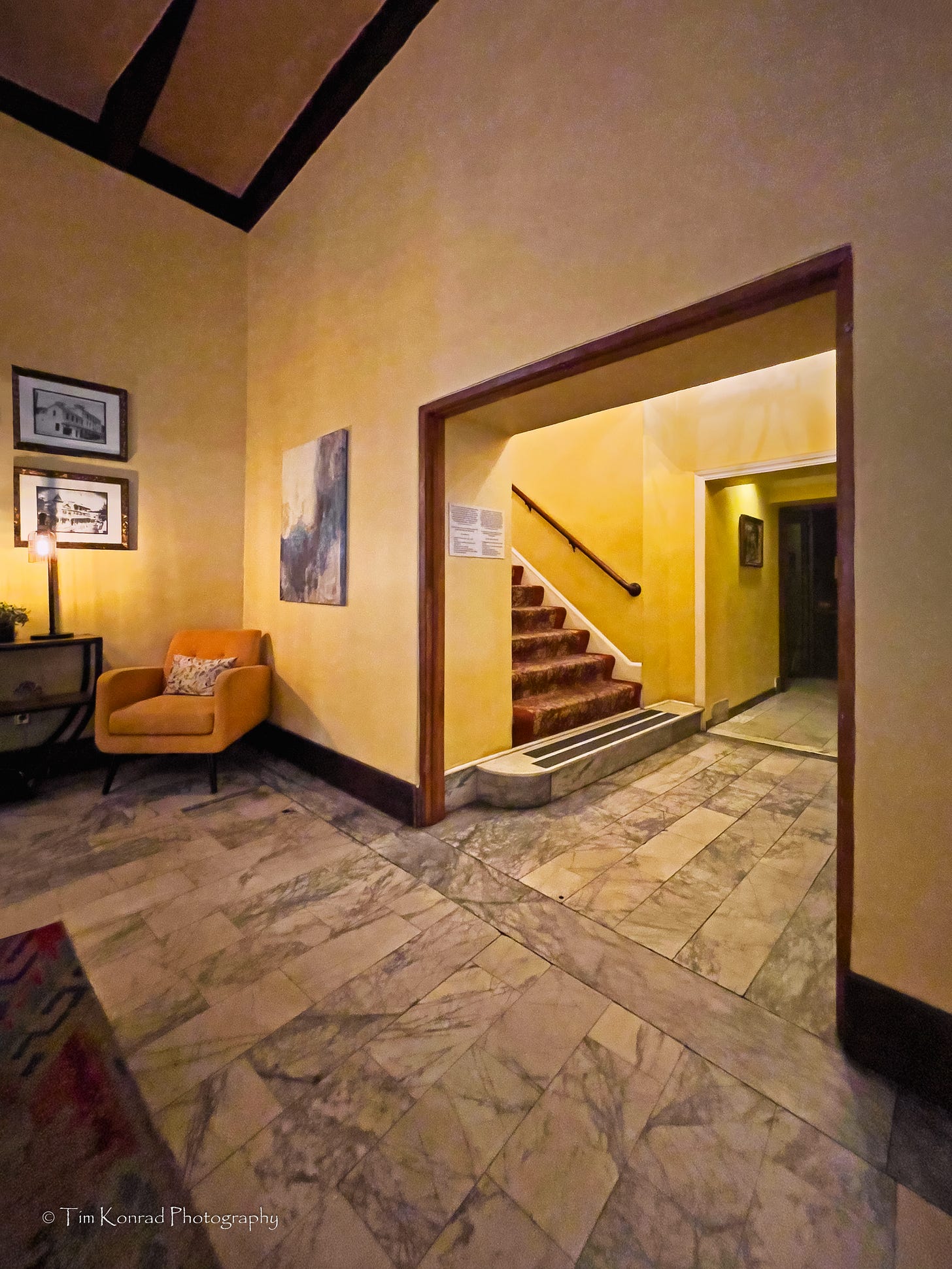The Sonora Inn
The Sonora Inn Lobby
In the mid 1950s, my parents reckoned me old enough to let me go downtown by myself in the evenings, both to go to the movies, but also, when the movie companies came to film, to seek autographs from the film’s actors and actresses and supporting staff.
One location that promised results was the Sonora Inn, where many of the movie folks were housed during shooting. By haunting its lobby, I’d made the acquaintance of a Filipino bellhop who would obligingly signal me, by glance or hand gesture, when a film production employee made an appearance.
While the bellhop’s tips were usually spot-on, he wasn’t above a little light-hearted trickery, like the time he directed my attention to a man who turned out to be a local rancher, Frank Kurzi. The fellow actually was at the hotel on movie business, but he was one of the locals who provided location services to the production.
In spite of the bellhop’s penchant for play, his participation in my scheme enabled me to build a respectable autograph collection over the span of the several years I pursued it.
The local motion picture association in those days was instrumental in bringing movie production companies to town. Due to its efforts, a lot of movie companies came to Sonora to take advantages of the area’s scenic attributes, its railroad and historical settings. It was a different time, before the expenses of shooting films on location had risen sufficiently to motivate movie companies to seek less expensive alternatives in places like British Columbia.
Looking back, it’s surprising no-one ever hassled me about my enterprise. It must have been at least a little annoying or disruptive to have a kid hanging out in the lobby waiting to pounce on unsuspecting guests without warning to hound them for their autographs.
In my defense, I was discreet in how I approached my intended subjects, or at least as discreet as a moderately perceptive eleven-year-old boy is capable of being, I had already developed a limited sense of propriety, fear-based though it was, through being scolded pre-emptively (translation: warned), by our next-door neighbor, Josie, never to attempt to assail the A-Grade actors—Gary Cooper, Ingrid Bergman, Claudette Colbert were a few— and actresses who were billeted in the exclusive, secretive private “motel” where she was employed as a cleaning lady.
I knew never to go there and I never did.
The mere knowledge that there were limits that needed to be observed concerning the business of autograph-collecting tempered my approach, so I treaded lightly in my endeavor and, fortunately, never experienced any negative consequences as a result.
Most of those who obliged my obsession were support staff, members of various technical crews or bit players, but there were a handful of supporting actors I met, and a few actual “stars” as well.
The first “famous” actor that comes to mind is Randolph Scott. A staple of “B” westerns when I was growing up, Scott was typical of the ruggedly-handsome alpha-male type actors popularly cast in leading roles in those days. I never saw Randolph Scott play a role I didn’t thoroughly enjoy.
Another leading man was Barry Sullivan. I caught him in front of the Inn as he was preparing to drive off with his leading lady, beautiful young Mala Powers, in a fancy convertible.
Curiously, one of the more interesting people I met in this way was an old character actor by the name of Edgar J. Buchanan. He was one of those actors with a knack for knowing how to inhabit meaty supporting roles with scene-stealing authenticity, the way Ned Beatty did a few decades later, without unduly distracting the audience from the story line.
Over time, my interest in collecting autographs flagged, interrupted by adolescence and its attendant uncertainty and confusion.
The Stairwell to the Upper Floor Rooms at the Sonora Inn
At one point in my childhood, the Sonora Inn came to assume an iconic status for me in another and totally different way entirely, one that had to do with the stairwell pictured above. These steps led to the hotel’s upper floors, and became, in my naive child’s mind, symbolic of what it meant to be an adult.
What do a set of stairs in a hotel lobby have to do with adulthood? Please allow me to explain.
For some childish reason, I at one time believed that one of the indicators of adulthood was having the freedom, if one chose, to stay up all night. This wasn’t surprising, considering that one of the most annoying things about childhood, for me, anyway, was “bedtime.” I never took kindly to being told I had to go to bed at some arbitrary-seeming time, so, in the simple math of the almost adolescent, the conflation actually added up.
What gave the symbolism its stamina, however, and its staying power, was how it came to me . . . in a dream!
The dream itself was short, simple and straightforward. It took place in the wee hours of the morning, perhaps 2:30 am or so, and in it, I was descending the storied stairwell. During the dream, my presence and participation indicated to me that I had “achieved” grownup-ness, that I would never again be required to endure the indignity of being told it was time to go to bed.
One of the things that give dreams their power is the realization that the subconscious, in choosing to make a production, or dream, out of something that was previously only an impression, elevates it by imparting it with a gravity that gives the experience meaning beyond the immediately apparent. In other words, when something rises to the level of a dream its elevation gives it prominence and added importance.
As a result, this image of what I imagined being a grown-up person would be like was an idea I carried around in my head for years afterward, conjuring it up every time I found myself contemplating the mysteries unfurling before me as I hurtled headlong toward autonomy.
Ready and eager to embrace the freedom of adulthood, but clueless concerning the responsibilities it entailed, I was no more prepared for the world I was anxious to enter than an oyster facing a barbecue.




